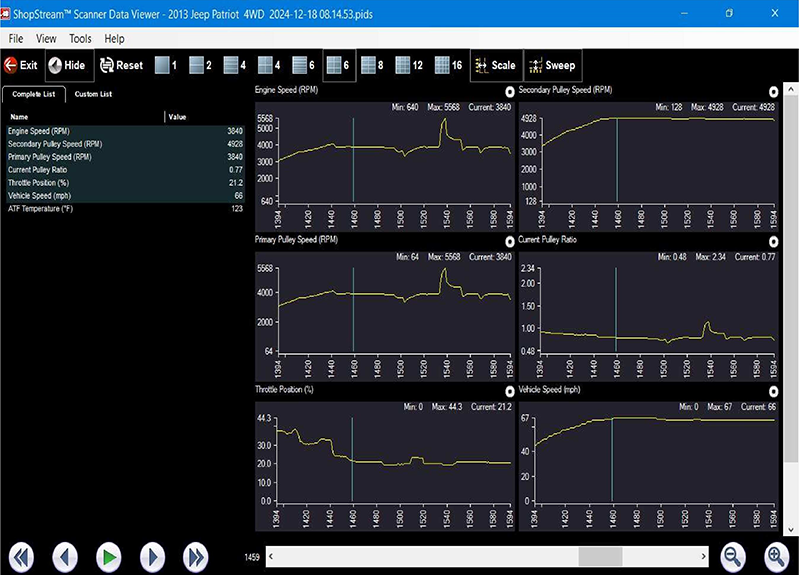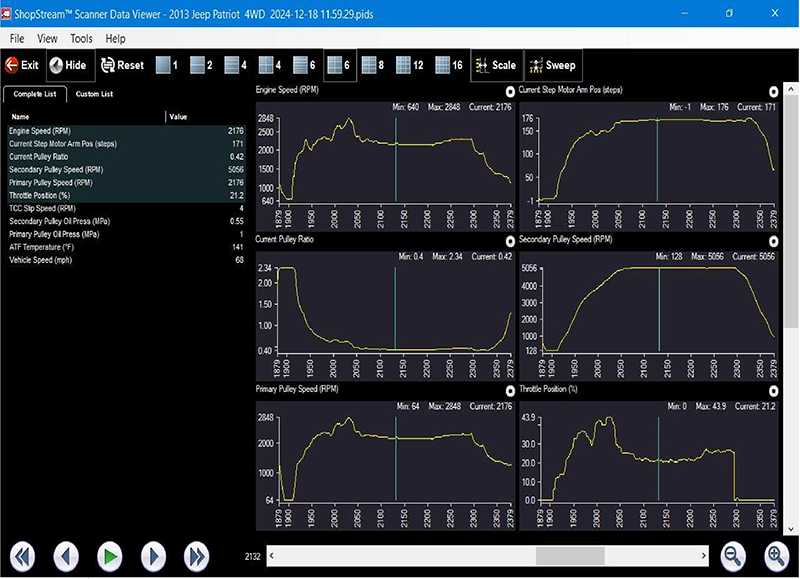A customer brought in their 2013 Jeep Patriot AWD equipped with a 2.4L engine and a JF011E transmission into our shop, complaining that the transmission warning lamp would illuminate after 25 miles of driving. I scanned the vehicle and discovered that it had stored diagnostic trouble codes P0730 (incorrect gear ratio), and P0766 (secondary pressure solenoid stuck off). When interpreting these codes, it was clear to me that the P0766 code indicated that the solenoid had reached its limit and could no longer achieve its goal. On the other hand, the P0730 code suggested that the transmission was failing to achieve the proper gear ratio. During my inspection, I also checked the tire stagger, finding the tires measured @ LF: 86", RF: 86.25", LR: 85.25", and RR: 85.25". It's important to note that even a half-inch difference in tire stagger can significantly affect an all-wheel-drive application.
Before making any recommendations, I decided to drive the vehicle and personally assess the codes. While driving, I noticed that the vehicle was not achieving the proper gear ratio, as the engine would never drop below 3800 RPM on the highway. This observation was unusual for a Patriot or Compass with this transmission and should have been my first indication that something was amiss. I drove the vehicle back to the shop still puzzled by the P0730 code, which was the one that stood out to me the most. I had never encountered this code on a Patriot or Compass with the JF011E transmission before.
I began my research by looking for any relevant articles on Identifix, Alldata, ATRA, and ATSG. After an extensive search, I was unable to find any articles that addressed the specific unit and the issues I was encountering. With no clear guidance available, I concluded that installing a reman transmission would be the best course of action. I also recommended to the customer that they should replace all four tires with matching ones as soon as possible to prevent future transmission and PTU damage.
We received the new transmission, and the technician installed it without any issues. After the installation, I reset the adaptive values, updated the ECM, and verified that the TCM had the current calibrations. I then cleared the codes and took the vehicle for a test drive. To my surprise, the vehicle behaved exactly the same as it did before the transmission replacement. The engine still wouldn't drop below 3800 RPM on the highway under light throttle, and the gear ratio remained above 0.7 unless I let off the throttle. Frustrated, I drove back to the shop and scanned the vehicle again, but no new DTCs were present in the ECM or TCM. (Figure 1)

Figure 1
Determined to get to the bottom of the issue, I pulled up the transmission data on my scan tool and conducted another road test. Once again, the engine RPM remained stubbornly high, and the gear ratio still refused to drop below 0.7. After the test drive, I returned to the shop and resumed my research, hoping to find some overlooked information that could provide a solution.
My research efforts were once again fruitless, so I decided to consult the lead Diagnostician for assistance. I explained to him the steps we had taken and the persistent issues we were facing. He promised to do some research on his end and get back to me with any findings. A little while later, I received an email and a phone call from him. He had found an article that closely matched the symptoms we were experiencing and advised me to read the email for more details.
The article, which was listed under "CVT2 transmission" (a different name for the JF011E; like a generic term for this transmission family). The article explained that the transmission control module (TCM) was unable to properly lower the gear ratio below 0.7 when it should normally go down to 0.45. This information was a revelation, as it perfectly described the problem we were dealing with. (Figure 2)

Figure 2
Armed with this new knowledge, I sourced a TCM from a salvage yard and installed it temporarily in the vehicle. I plugged in my scan tool once again and took the vehicle for another test drive. To my relief, the gear ratio finally dropped to 0.45, and the engine RPM was exactly where it needed to be.
So now where do I go? I just installed a transmission that did not fix the concern. Part of my decision to replace the transmission was due to the condition of the fluid, which was in poor shape. We called our remanufacturing facility in Omaha and told them we were sending up a unit for inspection. When we got that report back, I felt a little better, the transmission was failing and did not have many miles left on it. We still contacted the customer and explained what we had found and ultimately let the customer decide if he wanted his original transmission installed back into the vehicle. He really wanted to get 4-5 more years out of the "old girl" and wanted us to leave the reman unit in and also asked if it would be better if he bought a new TCM. After we explained that there is very little benefit to a new one provided the used one was functioning correctly, the customer optioned to keep the used TCM in the vehicle.
Reflecting on this experience, I realized the importance of considering all possibilities and trusting your instincts. Despite my extensive research and methodical approach, the solution was not as straightforward as I initially thought. This ordeal taught me that sometimes the answers lie in the least expected places, and it's crucial to keep an open mind and be persistent in the face of challenges.
 Certified Transmission
Certified Transmission
